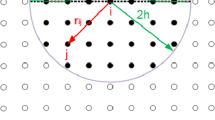Abstract
Agglomerates in water-based drilling cuttings could reduce the separating efficiency of solid–liquid materials and increase the difficulty of dehydration processing. In order to reveal the interaction mechanism of the particles and agglomerates for improving the processing efficiency, a new method of using the ultrafine particles in the water jet to impact wet agglomerates is proposed. Firstly, the interaction forces between the wet particles are analyzed and discussed theoretically. Then, based on the contact model and actual particle size, the boundary conditions and simulation model are decided and built by using discrete element method. Lastly, by carrying out the numerical simulations of the interaction process, the influences of the ultrafine particle sizes and initial velocities on the disaggregation of wet agglomerates are discussed for revealing the disaggregation mechanism of the wet agglomerates. Study results show that: (1) at fixed initial velocity, the bond failure rate of the wet agglomerates increases with the particle size. Besides, when the ultrafine particle size arrives to 0.3 mm and its initial velocity exceeds 90 m/s, the bond failure rate of the agglomerate could reach to 95%. (2) At fixed particle size, the bond failure rate of the wet agglomerates increases with the initial velocity of the ultrafine particles. However, when the ultrafine particle size is smaller than 0.1 mm, the influence of the initial velocity on the disaggregation of the wet agglomerates could be too small to be observed. (3) For a higher disaggregation effect, a bigger ultrafine particle size with higher initial velocity will be recommended.














Similar content being viewed by others
References
Nascentes CL, Murata VV, Oliveira-Lopes LC (2022) Mathematical modeling of solids-drilling fluid separation in shale shakers in oil fields: a state of art review. J Petrol Sci Eng. https://doi.org/10.1016/j.petrol.2021.109270
Thornton C, Liu L (2004) How do agglomerates break? Powder Technol 143–144:110–116. https://doi.org/10.1016/j.powtec.2004.04.035
Mitarai N, Nori F (2006) Wet granular materials. Adv Phys 55(1–2):1–45. https://doi.org/10.1080/00018730600626065
Jiao Y, Zhang XX, Kong FC, Liu HS (2015) Discrete element simulation of impact disaggregation for wet granule agglomerate. Wuli Xuebao/Acta Physica Sinica 64(15):1–10. https://doi.org/10.7498/aps.64.154501
Wang H, Jiao Y, Xin WY (2015) Liquid bridge force in wet particle separation and critical separation initial velocity. Coll Phys 151:10–17. https://doi.org/10.1145/3132847.3132886
Khinast MWSRJG (2012) A model to predict liquid bridge formation between wet particles based on direct numerical simulations. AIChE J 59(4):215–228. https://doi.org/10.1002/aic
Kan H, Nakamura H, Watano S (2018) Effect of collision angle on particle-particle adhesion of colliding particles through liquid droplet. Adv Powder Technol 29(6):1317–1322. https://doi.org/10.1016/j.apt.2018.02.026
Daryosh MKJOARF (2012) A regime map for the normal surface impact of wet and dry agglomerates. AIChE J 59(4):215–228
Zhang Z, Cheng J, Liu F, Qi J, Xu Z (2021) A calculation method for capillary force considering particle size and liquid bridge volume. J Hydr Eng 52(4):442–460
Chen H, Liu W, Zheng Z, Li S (2021) Impact dynamics of wet agglomerates onto rigid surfaces. Powder Technol 379:296–306. https://doi.org/10.1016/j.powtec.2020.10.071
Ahmadi Motlagh AH, Palanisamy K, Pougatch K, Salcudean M, Grace JR, Grecov D, McMillan J (2019) Mechanistic model to simulate wet agglomerate breakage in a gas-solid fluidized bed. Chem Eng Sci 195:995–1009. https://doi.org/10.1016/j.ces.2018.10.045
Qi H, Wang J, Gu X, Feng L (2019) Research progress on agglomeration mechanisms and fluidization behavior of cohesive particles. The Chin J Process Eng 19(1):55–63
Hu D, Zhuang J, Ding M (2012) A review of studies on the granular agglomeration mechanisms and Anti-agglomeration methods. Key Eng Mater 501:515–519. https://doi.org/10.4028/www.scientific.net/KEM.501.515
Vo TT, Mutabaruka P, Nezamabadi S, Delenne JY, Izard E, Pellenq R, Radjai F (2018) Mechanical strength of wet particle agglomerates. Mech Res Commun 92:1–7. https://doi.org/10.1016/j.mechrescom.2018.07.003
Khalilitehrani M, Olsson J, Daryosh F, Rasmuson A (2019) The morphology of the deposited particles after a wet agglomerate normal surface impact. Powder Technol 345:796–803. https://doi.org/10.1016/j.powtec.2019.01.065
Lian G, Thornton C, Adams MJ (1993) A theoretical study of the liquid bridge forces between two rigid spherical bodies. J Coll Interf Sci 161(1):138–147. https://doi.org/10.1006/jcis.1993.1452
Pitois O, Moucheront P, Chateau X (2000) Liquid bridge between two moving spheres: an experimental study of viscosity effects. J Colloid Interface Sci 231(1):26–31. https://doi.org/10.1006/jcis.2000.7096
Goldman AJ, Cox RG, Brenner H (1967) Slow viscous motion of a sphere parallel to a plane wall-I motion through a quiescent fluid. Chem Eng Sci 22(4):637–651. https://doi.org/10.1016/0009-2509(67)80047-2
Youxiang Z, Xiao X, Jian T (2019) Impact disaggregation simulation of wet coal agglomerate using discrete element method. Coal Eng 51(12):1–5
Acknowledgements
This work is financially supported by the Science and Technology Planning projects in Sichuan Province(2021YFG0264) and the National Natural Science Foundation of Youth (61801319).
Author information
Authors and Affiliations
Corresponding author
Ethics declarations
Conflict of interest
The authors declare that they have no conflict of interest.
Additional information
Publisher's Note
Springer Nature remains neutral with regard to jurisdictional claims in published maps and institutional affiliations.
Rights and permissions
Springer Nature or its licensor holds exclusive rights to this article under a publishing agreement with the author(s) or other rightsholder(s); author self-archiving of the accepted manuscript version of this article is solely governed by the terms of such publishing agreement and applicable law.
About this article
Cite this article
Liu, Z., Chen, L., Cao, X. et al. Simulation study on the disaggregating mechanism of wet agglomerates in water-based drilling cuttings based on discrete element method. Comp. Part. Mech. 10, 615–625 (2023). https://doi.org/10.1007/s40571-022-00516-3
Received:
Revised:
Accepted:
Published:
Issue Date:
DOI: https://doi.org/10.1007/s40571-022-00516-3



